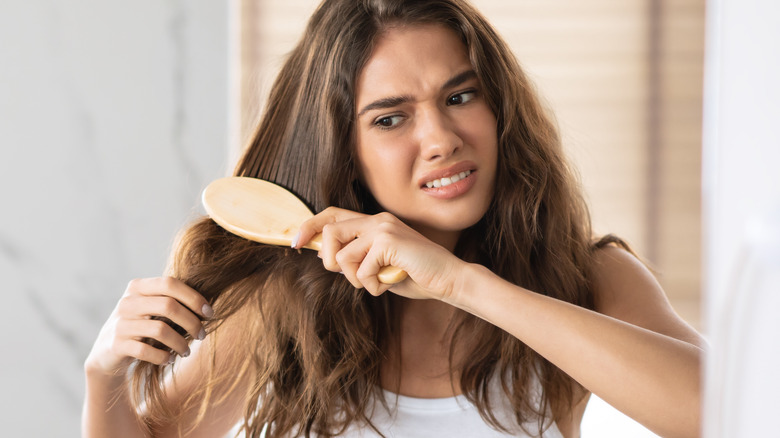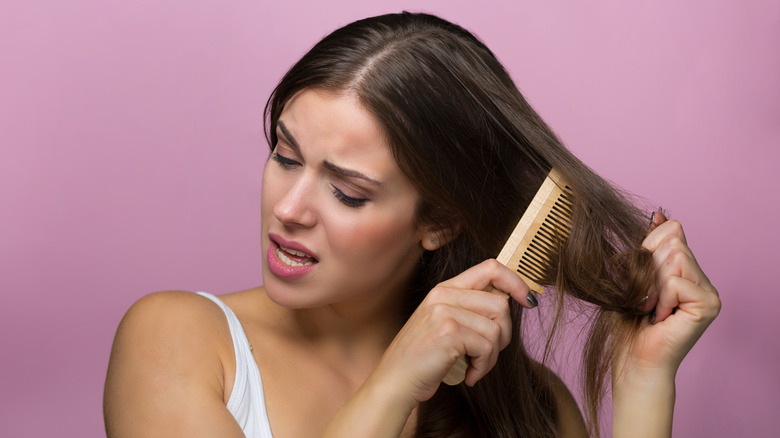How To Prevent Your Hair From Tangling All The Time
When it comes to hair problems, we often feel like we have to pick our battles by accepting smaller issues like tangles and split ends so we can spend more time and energy on the bigger ones such as dandruff and hair fallout. You might even believe that it only takes a couple of painful minutes to untangle knots, and you can power through it to get dreamy-smooth locks. But by doing this, you're only tending to the surface level of the problem without addressing the deeper root causes.
It's a common misconception that brushing your hair when it's wet is the secret to tangle-free tresses. But doing this has the potential to do more harm than good, particularly if you have straight hair. Brushing while wet can make fine or straight hair more prone to breakage by tugging at the strands too roughly when they're at their weakest after water absorption. However, if you have curly or textured hair, it might help you keep it tangle-free and give your curls the definition you crave too.
Outside of brushing, there are several steps you can take to prevent tangling but it's important to know that your hair might still knot due to natural causes like your hair type. It becomes a real problem when it's an everyday occurrence. However, you can minimize the pain of detangling and the frequency of it with a few simple tweaks.
Why your hair gets tangled in the first place
The first step to dealing with any problem is to know what's causing it so you can prevent the main trigger. Sometimes, tangles occur due to natural causes that aren't necessarily preventable. One of the most major ones is having textured or curly hair. Award-winning hairdresser Bruno Marc explained this to Heat World: "The main reason why curly hair gets so tangled is that it is more porous. This means that the hair does not retain as much moisture, which in turn can lead to it becoming more dry, matted, and tangled."
Even though you can't control your hair type, there are still several routes you can take to give your curls the love they need to stay as knot-free as possible — but more on that later. Another cause of tangles that is preventable has to do with how you dry your hair and how you sleep. When you rub your hair against a surface like a towel or sleep with it loose against your pillow, you create friction, which leads to tangling.
Knotted hair can also be a sign of damage and dryness. As dermatologist Iris Rubin, MD, informed Byrdie, "Tangling is more common in dry and damaged hair because the cuticles don't lie flat, which allows strands to snag against each other and become intertwined." Some other possible causes include chemically-treated or sun-damaged hair, excessive use of styling products, and longer hair, which generally tangles more.
There are several ways to prevent knots
One of the best things you can do for your curly or dry hair is to regularly nourish it with some moisture. Speaking to Allure, celebrity hairstylist Nai'vasha Johnson recommended deep-conditioning textured hair once a week to reinforce it with a slippery barrier that prevents curls from latching onto each other and creating tangles. To prevent tangling due to friction, you should switch out your regular towel for a gentler microfiber one or even use a microfiber hair wrap.
Likewise, swap out your pillowcases for silk pillowcases that don't cause friction as you toss and turn during the night. For extra sleep-time protection, you can also tie your hair into a loose braid. Since tangles are more common in long hair due to split ends, getting your hair regularly trimmed can also be beneficial. Despite your best efforts, knots might still develop, but there are a few things you can do to reduce the pain involved in the detangling process.
Instead of going through your dry hair with a brush, use your fingers to gently detangle it before conditioning. To kill two birds with one stone, you can use a wide-tooth comb to apply the conditioner while gently detangling. When working through knots, don't move the brush from top to bottom but the other way around to prevent extra tugging that can weaken the hair cuticles. Never be rough with your hair, and be patient to get the best results without the damage.


